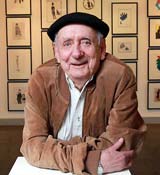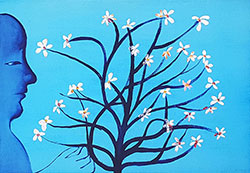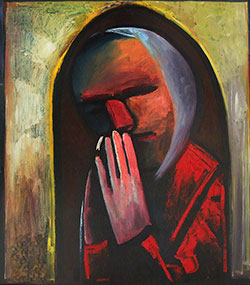
1928 Born – 2018 Died, Sydney, Australia
1943-46 Studied East Sydney Technical College
1945-60 Lived and painted in Melbourne
1950s Painted Schoolgirl series, followed by Alice in Wonderland series
1960-64 Travelled and studied overseas after winning Helena Rubinstein Scholarship
Lived and painted in London, exhibited at Whitechapel and Tate Galleries
1965 Tour of northern France and Flanders
1966-74 Lived and painted in Sydney
1975 Occupied Australian Studio, Cite Internationale des Arts, Paris
1976-2001 Lived and painted in NSW, Queensland, WA
1953-93 Numerous solo exhibitions in Sydney, Canberra, Melbourne, Brisbane, Adelaide, Perth, London and Tokyo, including a major retrospective at the National Gallery of Victoria, 1993 – Charles Blackman: Schoolgirls and Angels
1997 OBE
1963 Georges Invitation Art Prize, Georges Gallery Melbourne (one painting and one drawing)
1960 Helena Rubinstein Scholarship, Melbourne
1960 George Crouch Prize, Ballarat Fine Art Gallery
1960 Wins prize. A. Shore, The Age (February)
1958 George Crouch Prize, Ballarat Fine Art Gallery
1958 Rowney Prize, Richmond Gallery Melbourne
National Gallery of Australia, and all state galleries
Numerous regional galleries and university collections
1993 Charles Blackman: Schoolgirls and Angels, catalogue for retrospective at National Gallery Victoria
1989 Shapcott, T., The Art of Charles Blackman, Andre Deutch, London
1983 Amadio,N., Orpheus the Song of Forever, Craftsman Press, Sydney
1982 Amadio, N., Charles Blackman’s Paris Dreaming, A.H. & A.W. Reed, Sydney
1980 Amadio, N., Charles Blackman: The Lost Domain, A.H. & A.W. Reed. Sydney
1967 Shapcott, T., Focus on Charles Blackman, University of Queensland Press, Brisbane
1965 Mathew, R., Charles Blackman – Monograph, Georgian House, Melbourne
Charles Raymond Blackman (12.08.1928-) was born in Sydney to mother Marguerite Jasmine Blackman, née Brown and father Charles Sevic Blackman. He had three sisters June, Doreen and Patricia. Charles junior was just 4 years old when Charles senior joined the army and on his return absconded from the family disappearing entirely from the lives of his 4 children and wife. Marguerite, better known as Daisy, reported her husband missing, but some decades later was discovered to have begun a new family in Queensland and had no interest in reconnecting with his children from his first marriage.
Daisy worked odd jobs to support her four children and was a doting mother, especially to her only son Charles. Young Blackman’s focus was never towards academia but he showed a prodigious talent for drawing from a young age. Daisy was a big promoter of Blackman’s skills at a young age, even submitting his work to Hallmark for publication on greeting cards. He left school at 13 in 1941 and worked as an illustrator with the Sydney Sun newspaper as a cadetship. Several of his cartoons were published along with major news stories and he specialised in war time graphics.
It was this cultivation of his draftsmanship talents during his work hours that inspired him to hone his skills by attending evening classes at East Sydney Technical College from 1943-46. Ultimately Blackman found once again the institutional learning environment was at odds with his autodidactic disposition and dropped out. He continued to draw and paint feverishly but was still more than 7 years away from holding his first solo exhibition.
In 1949 Blackman met a young Barbara Patterson in an art society called “Barjai – Miya Studio and Young Brisbane Artists of the 1940s: Towards Radical Practice” frequented by Barret Reid, Judith Wright and many other progressive academics. From here sparked a romance that would take flight through extensive letter writing until they were reunited in Sydney and promptly married in 1950. They embarked upon a rogue kind of life together moving to Melbourne in 1951. Indeed at one point they were squatting in a shed in a back yard only to hear of a small coach house for rent. They went and met the owner and after several cups of tea he lead them out through a dense back garden to the very shack they had been squatting in, so they moved back in and started paying rent. This coach house on Cristobel Crescent was to become an iconic address for the duo where Blackman’s iconic Schoolgirls as well as Alice in Wonderland paintings were created. It would also be where they reared their two first born Auguste and Christabel. Barbara was declared legally blind and they lived principally off her pension as well as her professional modelling for artists including John Brack who favoured Barbara’s form for many of his early drawings and paintings. In 1953 Blackman held his first two solo exhibitions both in Melbourne within a few months of each other. The first in the livingroom of Mirka and Georges Mora within weeks of their meeting, a friendship that would last a lifetime, even garnering Blackman steady employment in Mirka’s infamous café working under chef Georges as a kitchen hand and dishwasher. Here Blackman displayed his Schoolgirl series at 9 Collins Street which began the iconic status of the Mirka’s home as a hub for eccentrics, artists and writers alike including Joy Hester, Laurence Hope, John Perceval, John Brack and patrons John and Sunday Reed. The second was held at Peter Bray Gallery and garnered much media attention for his representation of a swimmer. The artwork was considered scandalous with critics and the general public all weighing in on the age old debate of ‘what is art’ in the face of breaking the mould.
Art enthusiasts, movers and shakers, John and Sunday Reed who launched the careers of Sidney Nolan and many more, were to become instrumental in supporting Blackman through the development of his oeuvre. In 1959 the Antipodean Manifesto was drafted by Bernard Smith and signed by Charles Blackman, Arthur Boyd, David Boyd, John Brack, Robert Dickerson, John Perceval and Clifton Pugh. The purpose of the manifesto was to declare a united front protesting the progressing dominance of abstract expression in favour of figurative and the tangibly symbolic.
In 1960 Blackman was the recipient of the prestigious Helena Rubenstein scholarship which took the Blackman family to London and saw the birth of their son Barnaby in 1963. Great friendships with fellow expats were solidified with the likes of Barry Humphries, godfather to son Barnaby, as well as Brett Whitely and many more. He was exhibited widely including a group show at The Whitechapel Gallery. He was set for a solo show at Whitechapel, which due to unforeseen circumstances, purportedly protest from Hockney at the lack of support for London artists, it was cancelled at the last moment. Nonetheless a major body of work was produced during his six years in London and he received significant critical accolades across media platforms upon returning home to Sydney in 1966. That same year a portrait of Charles Blackman by long-time friend artist Jon Molvig won the Archibald Prize.
Just 4 years after returning home the Blackman family set sail for Paris after Charles was awarded a scholarship from the Cité des Arts for an atelier and stipend. During this time he again encountered fellow Australian expats including John Coburn. Blackman drew feverishly in Paris cafes and in the streets, fascinated by the cosmopolitan cafe lifestyle so different from foggy London and young Australia. Paris became a source of eternal inspiration for Blackman and he returned often. The family’s European jaunts were well documented in a bi-weekly half page in the Herald newspaper in Australia penned by Barbara, a budding writer and master of language. Readers delighted in receiving these exotic accounts of dynamic Paris, romantic Venice and more. During this time Blackman was also commissioned to do sets for the Western Australian Ballet Company, Sydney Dance Company and for Daisy Bates.
On returning home to Australia post-Paris malaise set in and Barbara and Charles set about supporting and enriching a more artistically driven education opportunity for the youths of Sydney to help shape their young minds into embracing the news possibilities offered by a broader education. They purchased Chiron College and operated the school our of a sandstone fort perched at the end of a cul-de-sac in Birchgrove. The school successfully converted a team of young Sydneians into lifetime bohemians and turned out many successful artists, writers and musicians through a celebration of their otherness.
In 1977 Blackman was awarded an Order of the British Empire for his great contribution to art and culture in both the UK and Australia. In 1978, after 27 years of marriage Barbara and Charles Blackman divorced. The following year in 1979 Blackman married young artist Genevieve de Couvreur, a former student of Chiron college and a close friend of his daughter Christabel. Genevieve and Charles embarked on a romantic whirlwind relationship that would bring two more children into the fold. First came Beatrice, known contemporarily by her stage name Bertie Blackman as an Aria award winning singer/songwriter and artist in her own right. The second, Felicien who is a rising star in the field of architecture. During this period Blackman’s continued success brought much comfort and joy to the family. His addiction to alcohol was beginning to seriously impact his relationship within a few years and the marriage ultimately ended.
In 1989 Blackman was to marry again, this time to an eccentric woman named Victoria Bower, with whom he had his sixth child named Axiom. The marriage ended when Victoria converted to Raelienism and she went on to join the cult’s Australian headquarters in Lismore, northern New South Wales.
A major retrospective of Blackman’s work curated by Felicity St. John Moore was held at the Art Gallery of New South Wales in 1993. A survey show reuniting all but one of his acclaimed Alice in Wonderland series was held at the National Gallery of Victoria in Melbourne co-curated by Geoffrey Smith and Felicity St. John Moore. In August 2010, The Blackman Hotel opened in St Kilda Road, Melbourne. It features 670 digitally reproduced fine art prints by Charles Blackman. Ursula Dubosarsky’s novel The Golden Day was directly inspired by Blackman’s 1954 painting Floating Schoolgirl, which is in the collection of the National Gallery of Australia in Canberra

November 14, 2020 - November 28, 2020

November 24, 2018 - November 30, 2018
Receive e-mail updates on our exhibitions, events and more
Subscribe Now